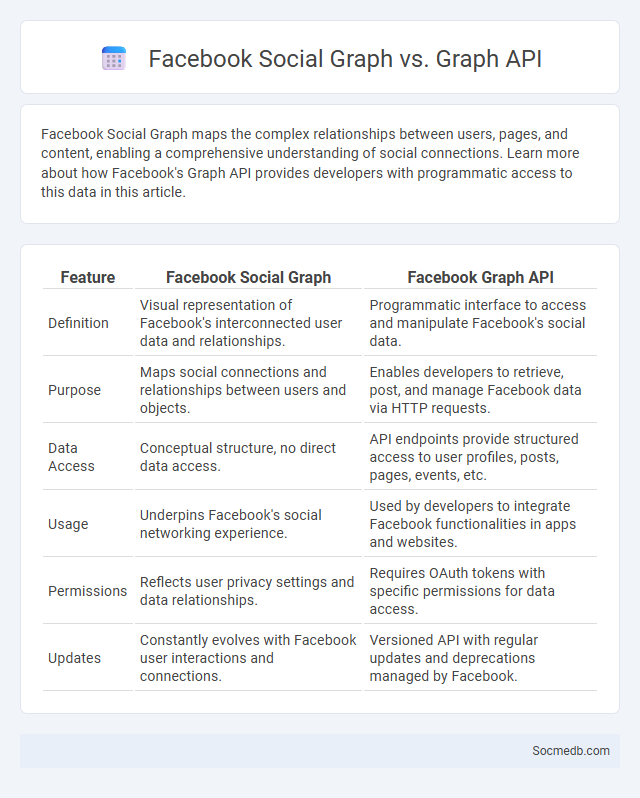
Photo illustration: Facebook Social Graph vs Graph API
Facebook Social Graph maps the complex relationships between users, pages, and content, enabling a comprehensive understanding of social connections. Learn more about how Facebook's Graph API provides developers with programmatic access to this data in this article.
Table of Comparison
| Feature | Facebook Social Graph | Facebook Graph API |
|---|---|---|
| Definition | Visual representation of Facebook's interconnected user data and relationships. | Programmatic interface to access and manipulate Facebook's social data. |
| Purpose | Maps social connections and relationships between users and objects. | Enables developers to retrieve, post, and manage Facebook data via HTTP requests. |
| Data Access | Conceptual structure, no direct data access. | API endpoints provide structured access to user profiles, posts, pages, events, etc. |
| Usage | Underpins Facebook's social networking experience. | Used by developers to integrate Facebook functionalities in apps and websites. |
| Permissions | Reflects user privacy settings and data relationships. | Requires OAuth tokens with specific permissions for data access. |
| Updates | Constantly evolves with Facebook user interactions and connections. | Versioned API with regular updates and deprecations managed by Facebook. |
Introduction to the Social Graph Concept
The social graph represents the network of relationships connecting individuals, organizations, and entities through social media platforms. It maps interactions such as friendships, follows, likes, and shares, enabling platforms like Facebook and LinkedIn to analyze user behavior and recommend relevant content. Understanding the social graph is crucial for leveraging social media analytics, targeted advertising, and enhancing user engagement strategies.
What is Facebook’s Social Graph?
Facebook's Social Graph represents the digital mapping of connections between users, pages, events, and interests, illustrating how individuals interact within the platform's ecosystem. This graph enables personalized content delivery, targeted advertising, and fosters social discovery by analyzing the relationships and activities shared by users. Understanding your position in Facebook's Social Graph helps optimize engagement and enhances the relevance of your social media experience.
Understanding the Facebook Graph API
The Facebook Graph API provides developers with a powerful tool to access and interact with Facebook's social graph, enabling the retrieval of user profiles, pages, posts, and connections based on defined permissions. It uses structured queries and edge relationships to fetch data efficiently, supporting real-time updates and deep integration with Facebook's ecosystems. Mastery of access tokens, API versioning, and privacy settings is essential for maximizing functionality and maintaining compliance with Facebook's policies.
Social Graph: Broader Definitions and Uses
The social graph represents the network of relationships and interactions between individuals and organizations on social media platforms, enabling targeted advertising, personalized content delivery, and enhanced user engagement. Broader definitions of the social graph incorporate not only direct connections but also shared interests, groups, and behavioral patterns, expanding its utility in data analytics and social influence measurement. By leveraging complex social graph data, businesses can optimize marketing strategies, improve recommendation systems, and foster community growth through deeper insights into user dynamics.
Key Differences: Facebook Social Graph vs Graph API
The Facebook Social Graph represents the interconnected relationships between users, pages, and content, mapping the social interactions that define user connections and network behavior. In contrast, the Graph API is a tool that allows developers to access and manipulate this data programmatically, enabling your applications to read and write information on Facebook's platform securely. Understanding these key differences helps optimize your social media strategies by leveraging the Social Graph's relational insights through the Graph API's robust interface for integration and data retrieval.
Applications of the Facebook Social Graph
The Facebook Social Graph enables applications to map and analyze relationships between users, enhancing personalized content delivery and targeted advertising. It supports features such as friend recommendations, event invitations, and social plugin integrations that increase user engagement across platforms. You can leverage this data to create more relevant and interactive social experiences tailored to your audience's connections and preferences.
Real-World Use Cases for Graph API
The Facebook Graph API powers real-world social media applications by enabling seamless access to user profiles, pages, photos, and comments for personalized content delivery and targeted marketing campaigns. Businesses leverage the Graph API to analyze audience engagement, automate post scheduling, and manage customer interactions across platforms like Instagram and WhatsApp. Developers integrate this API to build social analytics tools, enhance ad targeting precision, and create immersive social experiences by tapping into vast interconnected data sets.
Privacy and Security Implications
Social media platforms pose significant privacy and security challenges due to vast data collection practices and frequent exposure to cyber threats such as identity theft and account hacking. Users often unknowingly share sensitive personal information, which can be exploited through phishing attacks or unauthorized data mining by third parties. Strengthening privacy settings, utilizing two-factor authentication, and staying informed about platform policies are essential strategies to mitigate these risks.
Evolution of Social Graph Technology
Social graph technology has evolved from simple friend connections to complex networks integrating user interactions, interests, and behaviors across multiple platforms. Advanced algorithms now analyze vast amounts of data to map relationships and influence patterns, enabling personalized content delivery and targeted advertising. The integration of AI and machine learning has further enhanced the accuracy of social graphs, driving innovations in user engagement and social network dynamics.
Future Trends and Innovations
Social media platforms are increasingly integrating AI-driven personalization and augmented reality to enhance user engagement and deliver immersive experiences. Innovations such as decentralized social networks and blockchain technology promise to redefine data privacy and content ownership. Staying informed about these future trends can empower your strategy to leverage evolving tools and maintain a competitive edge.
 socmedb.com
socmedb.com